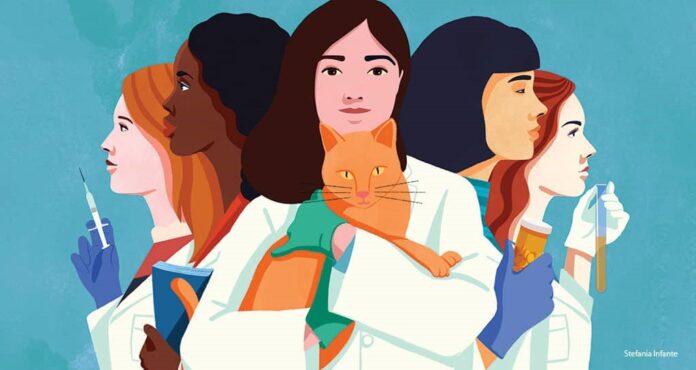Female Veterinarian Shaping innovations in Animal research and Healthcare
Dr. Monoshree Sarma1; Dr. Mrinmoyee Sarma2, Phunu Taukdar3
- Assistant Professor, Department of Veterinary Pharmacology and Toxicology, Intitute of Veterinary Science and Animal Husbandry, Siksha ‘O’ Anusandhan, Deemed to be University, Bhubaneswar-751030
- Assistant Professor, Department of Veterinary Pharmacology and Toxicology, Intitute of Veterinary Science and Animal Husbandry, Siksha ‘O’ Anusandhan, Deemed to be University, Bhubaneswar-751030
- Block Veterinary Officer, Mobile Veterinary Unit, Kamalpur, Kamup, Assam -784164.
The veterinary profession which was once considered as a male bastion is now dominated by women too. In tune with the escalating scopes of profession, large no of females have joined it. As per a report in the esteemed daily ‘The Hind’ worldwide 55% of the vets are women and in India, 70% of the students who have joined the profession are female.
Since antiquity, contribution of women in this profession is immense and has benefited the society at large. The demand and credibility for milk and dairy products is large .Women use to rear goat and cows to generate income to support their livelihood. They have made significant contribution in the growth of livestock industry. Today, along with prospering livestock industry, the entire globe is witnessing a rapid growth in pet industry and peripherals. And along with this, demand for manpower has also escalated. The growing demands of the profession and its associated opportunities have attracted many females to this field. The very first lady who entered into the noble profession of veterinary medicine in 1889 was Ms. Parisienne, and subsequently her footstep was being followed by Ms Pole Stephanie who later joined the profession in the same year. The lady vets of this era have has inspired many more females to enter the profession and currently the no is surpassing male vets in many developed and third world countries.
According to sources, the first woman to have entered into the sphere of veterinary medicine is Parisienne. Stephanie Kruszewska is believed to have followed her footsteps in Zurich University of Europe in the same year. Subsequently, with the enactment of Sex Disqualification Act (Removal), 1919, women were allowed into different professions throughout the world. This is a watershed moment in the history which has opened the door of veterinary science for woman; and in no time numbers of female veterinarian burgeoned and veterinary profession witnessed dramatic feminization. India too became accommodative for ladies in the domain of veterinary medicine. It was in 1948, when Madras Veterinary College allowed females to pursue degree in Bachelors of Veterinary Science and Animal Husbandry. Dr. Sakkubai Ramchandran, a graduate of Madras Veterinary College is the first female veterinarian of the country. She held many responsible positions and finally retired from the post of Scientist, IVRI (Indian Veterinary Research Institute, Bangalore. On 2nd Oct 1958, on the occasion of Gandhi jayanti, Female vet of India formed Indian Association of Lady veterinarian at veterinary college, Thrissur, Kerela. This landmark step boosted the confidence of women vets and provided a platform to display their potential and talent.
Female veterinarians are instrumental in contributing to the field of animal research and health care. One such outstanding lady veterinarian is Dr. John Hinton, who along with John Howard Mueller developed Mueller Hinton agar which is used to isolate the Neisseria bacteria which is the aetiological agent of gonorrhoea and meningogoccal meningitis. Mueller Hinton agar is commonly employed in disk diffusion method, a test used to check the susceptibility of bacterial isolates to antibiotics. MH agar can also be used c in the laboratory for the rapid presumptive identification of C. albicans, as an alternative method for germ test tube (Mattie AS,2014).
Dr. Victoria Johnson is a lady veterinarian who incorporated Telepresence technology into the field of veterinary medicine for conducting remote surgeries. Rem ote surgeries give access to the areas which is not accessible with routinely used surgical techniques and is thus adding a new dimension to the sphere of veterinary surgery.
Dr. Kathy Wright was the first veterinarian to introduce radiofrequency catheter ablation (RFCA) trearment into the field of veterinary medicine. With a success rate of 95%,the technique was able to cure rare but potentially fatal arrhythmia brought on by atrioventricular accessory pathways, one of the most common cause of rapid heartbeats in young dogs, especially Labradors.
Dd. Mary Beth Leinger, a veterinary graduate of Purdue has co-owned an AAHA-accredited hospital in Plymouth, Michigan, with her spouse. She has held many prestigious positions including member of Veterinary Licensing Board and Joint Commission on Controlled Substances.
Although women possess tremendous potential and have contributed significantly to upgrade the profession; they face certain challenges. There are many incidences witnessing inequalities within veterinary profession in terms of job offers, pay benefit, packages etc. Women are generally portrait as weak and fragile and hence are deprived of veterinary leadership or managemental positions. Females are not preferred in many higher positions owing to concerns like maternity leave, family responsibilities etc. Despite of these facts mentioned above, women across the world are breaking all serotypes and has blurred the line distinguishing men and women in professional career. More women today are entering the work force and consistently working to keep the flag of veterinarian high. In the recent years the veterinary corporate model has changed to a great extend and are addressing the concerns of women; thus welcoming more women to the profession. Women will constitute a substantial part of the profession and will occupy places in all ranks of the power structure.


